Interview with Leslie Supnet
By Christina Battle
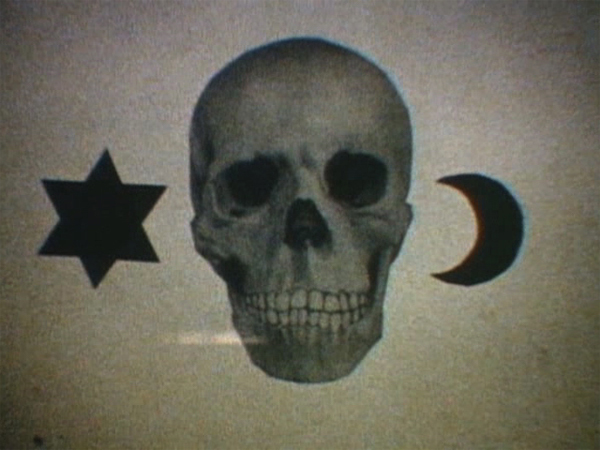 sun moon stars rain / Leslie Supnet
sun moon stars rain / Leslie Supnet
.
A prolific artist, Leslie Supnet’s work offers glimpses into the personal. Her delicate handmade films, which often present introspective and sometimes tragic stories, are always relatable. With many pieces grappling with ideas of place her filmography can be seen as a map of her own movements across the country – from her hometown of Winnipeg, to Toronto, and recently to Montreal. Her films are also utterly complex, often constructed within the confines of seemingly unpredictable formal restrictions. Both conceptually and formally, Supnet’s practice is one of controlling the uncontrollable. The following interview took place via email from January through June 2015.
* * *
Christina Battle: In a 2008 interview you did with Rik Leaf for the West End episode of The Artist Next Door you speak about the feeling of isolation that living in Winnipeg creates and how that helped shape some of the aesthetic choices in your work. In the interview you specifically talk about the visual isolation of characters in your images. Isolation is a conceptual thread that runs through a lot of your works – a lone character navigating the dark recesses of his or her thoughts. I wonder if this sense of isolation still influences your work now that you are living in Toronto?
Leslie Supnet: In Winnipeg there is a lot of space. The sidewalks are never crowded. Downtown is a ghost town after 5pm. In Winnipeg you have a lot of time. It doesn’t take much effort to get anywhere in under 20 minutes. You’re always trying to find something to do to combat whatever neurosis you’ve developed from living in the city. It is rare that events compete for the same audience, so the problem of having to curate your evening doesn’t exist. I don’t feel isolated now that I live in Toronto. That angst has disappeared. There’s a whole other set of problems that comes with living in a large, expensive city: there’s too much to do and see, and trying to survive as an artist means hustling all the time. My recent work deals with fantasy – psychedelic landscapes I dream to live in when I retire, whereas most of my early character-based animation deals with isolation and longing for human connection. I desire human connection less now that I’m surround by people all the time.
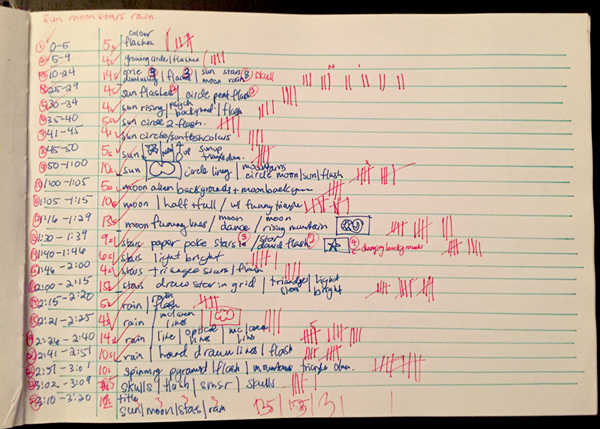 Shooting plan for sun moon stars rain / Leslie Supnet
Shooting plan for sun moon stars rain / Leslie Supnet
Battle: Sun moon stars rain (2009) feels psychedelic, not a psychedelic landscape exactly but more ritualistic. It’s as if the film itself is conjuring some sort of change, a spell to help issue in something new. Do you see this work as a pivot point toward the more psychedelic landscapes you’re now working on?
Supnet: Yes. As I got tired with character-based animation, I wanted to revisit the kind of animation I was doing with sun moon stars rain, but instead of transparency cut-outs I did classical hand-drawn paper animation with Second Sun (2014), also on Super 8. I’m currently working on a new landscape piece to be shot on some of the 16mm Ektachrome reversal I’ve been hoarding in my freezer!
Battle: Sun moon stars rain was made for the One Take Super 8 event in Winnipeg (which you have participated in a number of times).[1] Can you speak about making this particular film within the restrictions of the festival (working with a specific deadline, in camera edits, not seeing the film until exhibition night along with an audience)? The film is very intricate and contains a number of densely animated sequences; it’s hard for me to imagine how to make something so ultimately controlled within such unpredictable parameters.
Supnet: I find production restrictions to be very motivating, so the One Take Super 8 was an ideal event to sign up for. For the first One Take I participated in, I tried to make a character-based animation with paper-cut outs, which didn’t turn out. It was completely out of focus, due to my lack of experience with film, and was screened in front of 100+ people. It was horrifying. After that I learned quickly to pay attention! I’m a big fan of the in-camera edit and planned out the shoot for sun moon stars rain by choosing a song first (by Teeth Mountain, now disbanded), breaking the song down into seconds, and planning/choreographing each second with different transparencies. I recently finished my first 16mm color film, Ways + Means (2015), also an in-camera edit, applying what I’ve learned from all the One Take Super 8 events over the years.
Battle: A number of your films include imagery that point toward darker, otherworldly things: skulls; ritual; Baphomet; pyramids, etc. What’s your relationship to these images?
Supnet: These images point to my interest in alternate reality and the unknown. One of my favorite radio programs is Coast to Coast AM with George Noory. It’s a late night talk show that deals with conspiracy theories and the paranormal. For the most part, I listen for entertainment but there are points at which I’m lying in bed in the dark listening to someone’s eyewitness account of a UFO/Bigfoot/ghost encounter and I’m suddenly no longer laughing. I realize the world is a great mystery that I will never fully comprehend.
Battle: Many of your works seem to be reflections of real life experiences. In an interview you did with Patrick Jenkins for Canadian Animation Blog in 2013, you talk about how animating gains + losses (2011) helped you cope with personal issues and the death of a family member. I wonder if you can speak more to this and about your work overall?
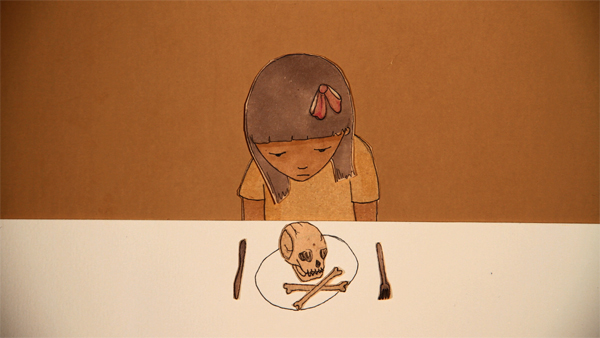 gains + losses / Leslie Supnet
gains + losses / Leslie Supnet
Supnet: Gains + losses is my most personal work to date. It’s based on a letter I wrote to my cousin Rowie, who committed suicide in the Philippines. I paired the narration with animated vignettes of new or already existing drawings I had made, to give the heaviness of the narrative some levity. How to Care for Introverts (2010) is less of a direct personal story, as the narration was found on the Internet, but I am an introvert so there was some catharsis involved in making that work. While researching online I did a Google image search for a visual reference on the mannerisms of introverted children: “hunched over lonely kid sitting in the corner,” that sort of thing. But as a result I stumbled across a point-form guide that looked like it was scanned from a parenting book called “How to Raise an Introverted Child,” which I used to create the script from. Things like: “Respect their need for privacy;” and “Don’t force them to make lots of friends.” It was really adorable. As an introverted child myself I always felt like something was wrong with me. I needed a lot of alone time and felt guilty about it. So making this piece was a nice way to work through these past grievances of being a bit of a gloomy kid.
Earlier works like Moving (2007), A Small Misunderstanding (2008), Fair Trade (2009), and Hang in There (2009), deal with inner conflicts I was having at the time, often with humor. Overall this set of works was a way for my voice to be heard, on some small level, as I often struggle with that.
Battle: Your films seem to fall into four main categories: those that relate personal issues and stories, which are usually animated (A Small Misunderstanding, Moving, Fair Trade, Hang in There, How to Care for Introverts, gains + losses, The Idea [2012], A Time is a Terrible Thing to Waste [2012]); remakes of scenes from other movies (The Animated Heavy Metal Parking Lot [2008], Star Wars Uncut [2010]); the more mathematically structured films, which often explore spiritual themes like New Ageism and Satanism, and which often combine hand-drawn images with found footage (Second Sun, Closed Circle of Worship [2009], sun moon stars rain, You Are Here [2012], Finding the Truth in the World Among Us [2013], Amethyst Visions [2012]); and the films that record, manipulate, and/or reconstruct scenes from real life (Last light breaking [2013], Allan Gardens [2014], Weekend [2012], Spectroscopy [2011]). I wonder how you approach the relationship of content to process – that is, how do you decide which idea will be visualized in which way?
Supnet: My early work was all character-based animation, as I came to cinema from a drawing practice. The only way I knew how to visualize my ideas at the time was through drawn characters, and I had quite the phobia with shooting live action. To this day I find it hard to hold down the trigger for longer than 10 seconds. It was through the One Take Super 8 event that I finally shot live action, which gave me the confidence to document in that way. Also, early on, experimental processes played a heavy role in how I thought about making work, by taking part in workshops like the Winnipeg Film Group’s 16mm Bolex Experiment, whose pedagogical lineage can be traced to Phil Hoffman’s Independent Imaging Retreat. It varies from project to project, and the medium can be dependent on factors such as time, commission restrictions, or aesthetic. Currently I’m focusing on hand-drawn abstract animation on Super 8 and 16mm.
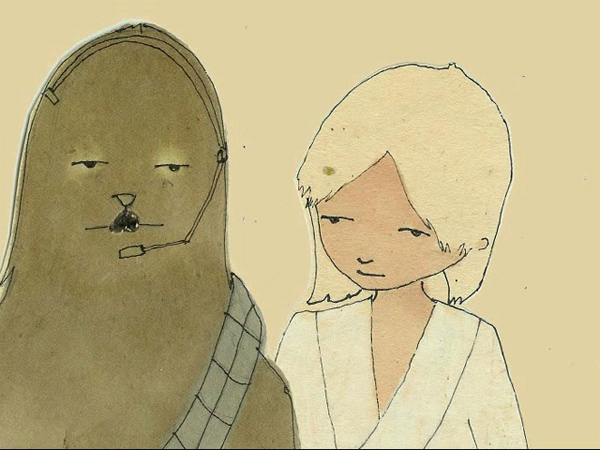 Star Wars Uncut – Scene 254 / Leslie Supnet
Star Wars Uncut – Scene 254 / Leslie Supnet
Battle: I’d love to hear more about Star Wars Uncut – Scene 254 and The Animated Heavy Metal Parking Lot. Both are character-based animations but they function quite differently than your other works. I wonder what your relationship is to the original movies and how this might account for the difference in both tone and sentiment.
Supnet: Star Wars Uncut – Scene 254 was made as part of this amazing crowd-sourced project, in which fans picked a scene that the project’s director isolated from the whole film, a 15 second clip, to remake. The scene could be remade as many times over by an unlimited amount of people. Only one scene would be chosen, though, for inclusion in the final, compiled Star Wars Uncut (2010) film, and luckily mine got the most votes for that scene!
The Animated Heavy Metal Parking Lot got a lot of traction at festivals due to it’s use of appropriated sound from the original Heavy Metal Parking Lot by Jeff Krulik and John Heyn, a 1986 documentary about Judas Priest fans and their tailgating antics in an arena parking lot in Landover, Maryland that became a cult classic and was traded on VHS. I originally made it as part of a Winnipeg Film Group remake contest, and it shared first prize with an Astron 6 remake of Weird Science (1985).
Those two projects got me into working with found media, which I still do to this day.
Battle: Earlier you mentioned being tired of the hand-drawn animation that your practice is known for. I know you started in drawing and naturally moved into animation later on and I wonder, when drawing, how you decide if something will remain static or ultimately move across time? How does your engagement with story play into this?
Supnet: My character-based drawing practice has come to a stand still in the past few years, as I’ve developed a moving image practice. It came to the point where I had my pencil in my hand, staring at a blank piece of paper, and said to myself, “I can’t do this anymore.” The issues I had been dealing with personally, which informed the subject matter of my drawing – isolated characters involved in some tragicomedy – were no longer present. These drawings became my signature and I started to feel confined by it, so much so that I physically couldn’t do it anymore. On rare occasions I draw in that style, for commissions or for special gifts. Some of the vignettes in gains + losses were existing drawings that I decided to animate, which I hadn’t done before. Now most if not all of the drawings I make are to be used in an animation.
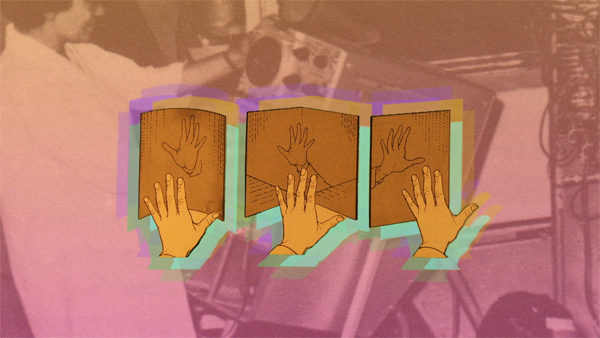 finding the truth in the world among us / Leslie Supnet
finding the truth in the world among us / Leslie Supnet
Battle: Finding the truth in the world among us (2013) was made for a POP Montreal commissioning project titled “Voices From Beyond: The EVP Project,” curated by Kier-La Janisse. Similar to sun moon stars rain, this work seems to be conjuring something, and invoking spirits. Can you speak more about its sound design? Although clearly referencing Electronic Voice Phenomena (EVP) (recordings of spirit voices), the sound is interestingly rooted in reality, primarily incorporating broadcasts from media sources.
Supnet: The sound for finding the truth in the world among us was completely designed by Clint Enns. He took a recording he made of an American AM radio station on a trip with a friend to the States. He usually records things he finds interesting knowing he will use them later, making his own source library for future projects. I completely trust Clint with my sound, and we’ve been working together since we both started our respective experimental film practices. I continue working with him to this day, and it’s different for each project. Sometimes I tell him what kind of tone I want, or am more specific and send him some audio that I think will work, that he then appropriates and adds his own design to. Then there are projects where I give him free reign, and it rules.
 Smoke / Leslie Supnet
Smoke / Leslie Supnet
Battle: Smoke (2014) contains the familiar uncertain anxiety of your other works but by imagining a violent volcanic eruption, the piece takes on issues of more collectively experienced disaster. What led to the shift from the individual toward the collective in this work?
Supnet: I finished Smoke while I was at York University, working on my thesis film that deals with catastrophe and the Apocalypse. Disaster and ruin imagery was heavy in my mind, and I found this image of Mt. Fuji erupting in a book when collaging one day. There’s a collective fascination with disaster imagery and finding beauty in decay that helps us (for better or worse) cope with the relentless persistence of catastrophe. I wanted to literally take a closer look at this disaster image, and scanned it to reanimate it and zoom in progressively to see what it would produce. Up close the image is not as interesting as seeing it at a distance. Distancing makes catastrophe at lot easier to digest.
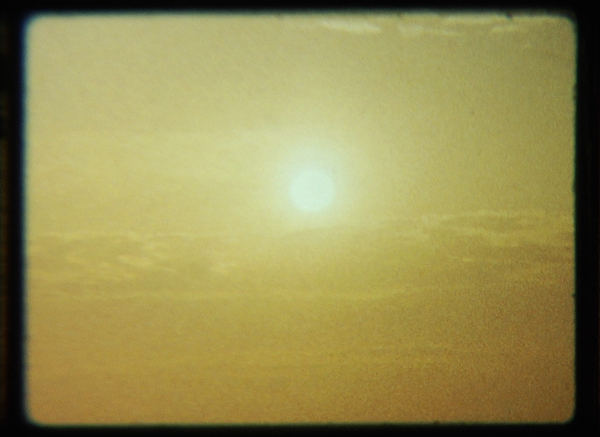 Ways + Means / Leslie Supnet
Ways + Means / Leslie Supnet
Battle: In your new film Ways + Means, you look outward to the city of Toronto and document it’s daily movement. What led to this outward gaze? The work was commissioned by Pleasure Dome for Art Spin, a bicycle tour of the city of Toronto, and will be presented outdoors on a hand-built, pedal-powered projector created by Martin Heath and Petra Chevrier on June 18th. Did you know the work would be projected in such a unique way while developing it? What challenges and/or freedoms did this allow for?
Supnet: Initially I was commissioned to make a new animation on 16mm for Pleasure Dome’s Art Spin event, but due to time and funding constraints I had to change the project. I decided to make a city symphony of Toronto instead, which was fitting, since I’d soon be moving to Montreal after creating the piece. In a way Ways + Means is a good-bye letter to Toronto. I wanted to replicate the many hectic moments as well as the periods of calm, when I could find it. As I mentioned, Toronto is an expensive city, and I wanted the title to suggest the struggles I faced trying to make it all work. But it was my home for three years, so capturing what I did find beautiful about the place was important, though it was difficult as well. I think making a city symphony of Winnipeg would be an easier task for me.
I knew from the beginning that the work would be presented on a pedal-powered projector. It’s an honor to have something shown on a hand-built artisan projector made by Martin Heath and Petra Chevrier. Actually, it’s a remake of a projector that Martin built a while back, that is stuck somewhere in Hamilton due to it’s size and weight, and which hasn’t been transported back to Toronto yet. This new projector is more portable – it can easily be used anywhere. It’s an amazing machine! Since the film’s projection speed is dependent on how fast or slow the user is peddling, it gave me freedom in shooting multiple exposures, pixellation and lots of shaking, trembling images.
NOTES
1. Created by Saskatoon-based Alex Rogalski, the One Take Super 8 Event began in Saskatchewan in 2000 with 20 filmmakers each shooting a single reel of Super 8 film, which then premiered to an audience without the filmmakers seeing their work beforehand. All the films were shown as shot. To date over 750 films have been created for the One Take Super 8 Event in chapters across North America.
Published June 18, 2015
ABOUT THE AUTHOR
Originally from Edmonton, Alberta, Christina Battle is currently based in Denver, Colorado. Her works are often inspired by the role of non-official archives, our notions of evidence, and explore themes of history and counter-memory, political mythology, and environmental catastrophe. A contributing editor to INCITE Journal of Experimental Media, Battle also co-curates and organizes the media arts exhibition series Nothing To See Here in Denver.
